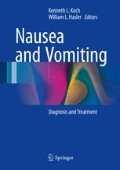Abstract
Chronic unexplained nausea and vomiting oftentimes result in caloric and vitamin deficiencies with or without weight loss. Patients with gastroparesis and nausea and vomiting have nutritional deficits, but few have had dietary counseling. Nutritional management can help to (1) improve caloric and vitamin intake in patients with gastroparesis or dumping syndrome and (2) reduce the postprandial symptoms of nausea and abdominal fullness and discomfort. In this chapter, we review approaches to nutritional management that allows patients with gastroparesis or dumping syndrome to reduce postprandial nausea by making diet choices each day based on key principles of gastric physiology and nutrition. Innovative ways to supplement diets for patients with nausea and gastric emptying abnormalities who have weight loss, vitamin or mineral deficiencies, or who need enteral or parenteral nutrition support are reviewed.
Access this chapter
Tax calculation will be finalised at checkout
Purchases are for personal use only
References
Stern RM, Koch KL, Andrews P. Nausea: mechanisms and management. New York: Madison Ave. Oxford University Press; 2011.
Camilleri M, Parkman HP, Shafi MA, Abell TL, Gerson L. Clinical guideline: management of gastroparesis. J ofGgastroenterol. 2013;108(1):18–38. doi:10.1038/ajg.2012.373.
Koch KL. Gastric neuromuscular function and neuromuscular disorders. In: Feldman M, Friedman LS, Brandt LJ, editors. Sleisenger and Fordtran’s gastrointestinal and liver disease: pathophysiology/diagnosis/management. Philadelphia: Elsevier, Inc; 2015. p. 811–38.
The NIDDK Gastroparesis Clinical Research Consortium (GpCRC). Dietary intake and nutritional deficiencies in patients with diabetic or idiopathic gastroparesis. Gastroenterology. 2011;141(2):486–98.e7. doi:10.1053/j.gastro.2011.04.045.
Abrahamsson H. Treatment options for patients with severe gastroparesis. Gut. 2007;56(6):877–83. doi:10.1136/gut.2005.078121.
Sadiva A. Nutritional therapy for the management of diabetic gastroparesis: clinical review. Diabetes Metab Syndr Obes. 2012;5:329–35. Published online 7 Sept 2012. doi:10.2147/DMSO.S31962. PMCID: PMC3460636.
Kreymann KG, Berger MM, Deutz NE, et al. ESPEN guidelines on enteral nutrition: intensive care. Clin Nutr. 2006;25(2):210–23.
Koch KL, Calles-Escandón J. Diabetic gastroparesis. Gastroenterol Clin North Am. 2015;44(1):39–57. doi:10.1016/j.gtc.2014.11.005.
Olausson EA, Störsrud S, Grundin H, Isaksson M, Attvall S, Simrén M. A small particle size diet reduces upper gastrointestinal symptoms in patients with diabetic gastroparesis: a randomized controlled trial. Am J Gastroenterol. 2014;109(3):375–85. doi:10.1038/ajg.2013.453. Epub 14 Jan 2014. PMID:24419482.
Parrish CR, Pastors JG. Nutritional management of gastroparesis in people with diabetes. Diab Spectr. 2007;209(4):231–4.
Institute of Medicine. Dietary reference intakes for energy, carbohydrate, fiber, Fat, fatty acids, cholesterol, protein, and amino acids. Washington, DC: National Academy Press/Food and Nutrition Board, Institute of Medicine, National Academies; 2005.
Koch KL. Review article: clinical approaches to unexplained nausea and vomiting. Adv Gastroenterol Hepatol Clin Nutr. 1998;3(4):163–78.
Mozaffarian D, Micha R, Wallace S. Effects on coronary heart disease of increasing polyunsaturated fat in place of saturated fat: a systematic review and meta-analysis of randomized controlled trials. PLoS Med. 2010;7(3):e1000252.
Duyff RL. Fat facts. In: American Dietetic Association complete food and nutrition guide. 4th ed. Hoboken: Wiley; 2012.
National Research Council (NRC). Recommended dietary allowances. 7th ed. Washington, DC: National Academy of Sciences; 1968.
Food and Drug Administration (FDA). Food labeling; mandatory status of nutrition labeling and nutrient content revision; format of nutrition label. Final rule. Fed Regist. 1993;58:2079–205.
National Research Council (NRC). Recommended dietary allowances. 10th ed. Washington, DC: National Academy Press; 1989.
Food and Drug Administration (FDA). Food labeling: reference daily intakes, Part II; final rule. Fed Regist. 1995;60:67164–75.
National Institute of Health Office of Dietary Supplements. Strengthening knowledge and understanding dietary supplements. https://ods.od.nih.gov/Health_Information/ODS_Frequently_Asked_Questions.aspx.
U.S. Environmental Protection Agency: Disposal of Medicines, Vitamins and Other Supplements. Website: nepis.epa.gov.
NIH Office of Dietary Supplements. dietary supplement fact sheets.
Johnson LE. “Overview of minerals”. The Merck manual. Professional version. Website: https://www.merckmanuals.com/professional/nutritional-disorders/mineral-deficiency-and-toxicity/overview-of-minerals.
Johnson LE. “Overview of vitamins”. The Merck manual. Professional version. Website: http://www.merckmanuals.com/professional/nutritional-disorders/vitamin-deficiency,-dependency,-and-toxicity/overview-of-vitamins.
Parrish CR, Yoshida CM. Nutrition intervention for the patient with gastroparesis: an update. nutritional issues in gastroenterology, series #30. Pract Gastroenterol. 2005;29(8):29–66.
Parrish CR, Lin HC, Parkman, H. Dietary and nutritional recommendations for patients with dumping syndrome (rapid gastric emptying). International Foundation for Functional Gastrointestinal Disorders. 2007.
Parrish CR, Ukleja A. Dumping syndrome. Nutrition issues in gastroenterology. Prac Gastroenterol. 2006;35:32–46.
Author information
Authors and Affiliations
Corresponding authors
Editor information
Editors and Affiliations
Rights and permissions
Copyright information
© 2017 Springer International Publishing Switzerland
About this chapter
Cite this chapter
Stuart, P.S., Hicks, D.C. (2017). Nutritional Management for Patients with Nausea and Vomiting and Gastroparesis or Dumping Syndrome. In: Koch, K., Hasler, W. (eds) Nausea and Vomiting. Springer, Cham. https://doi.org/10.1007/978-3-319-34076-0_11
Download citation
DOI: https://doi.org/10.1007/978-3-319-34076-0_11
Published:
Publisher Name: Springer, Cham
Print ISBN: 978-3-319-34074-6
Online ISBN: 978-3-319-34076-0
eBook Packages: MedicineMedicine (R0)

